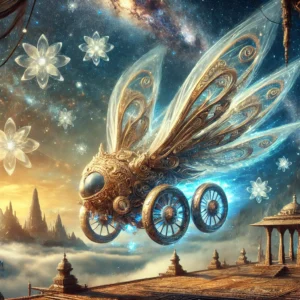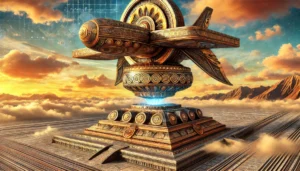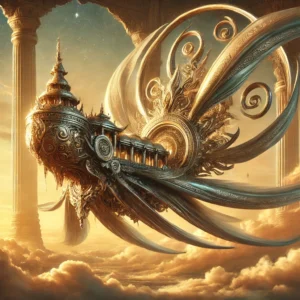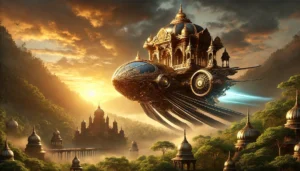
Myth or science decoding Pushpaka Vimana
The Aerodynamics of the Pushpaka Vimana: Myth or Science?
Published on Prachin Sanatan Yuga
The Pushpaka Vimana, one of the most enchanting accounts in Indian mythology, holds an enduring allure for those fascinated by the intersection of ancient wisdom and modern science. Described in the Ramayana as a divine aerial chariot used by Ravana, the demon king of Lanka, and later commandeered by Lord Rama, the vimana transcends the boundaries of mythology to evoke questions about ancient aerodynamics and technology. Could this be a fantastical creation of poetic imagination, or does it hint at an ancient understanding of aviation and aeronautics that modern science is only beginning to unravel?
The Pushpaka Vimana in Mythology
In Valmiki’s Ramayana, the Pushpaka Vimana is not merely a flying chariot but a marvel of engineering and artistry. Built by Vishwakarma, the divine architect, it was a gift to Kubera, the god of wealth, before being usurped by Ravana. This aerial chariot was described as:
Self-propelled: It could traverse the skies without external propulsion, defying gravity.
Luxurious and Spacious: Capable of accommodating many passengers, it symbolized both technological and cultural advancement.
Controlled by Willpower: The vimana obeyed the commands of its user, reminiscent of modern-day autopilot systems.
Omnidirectional Movement: It could move in any direction, highlighting unparalleled maneuverability.
The Pushpaka Vimana was more than a means of transport—it was a status symbol, a divine creation reflecting the technological sophistication of the gods.
Table of Contents

Myth or science decoding Pushpaka Vimana
The Science Behind the Myth: Aerodynamics and Design
Aerodynamics in Ancient Context
The flight of the Pushpaka Vimana, as described in the texts, suggests an implicit understanding of aerodynamics. Modern aircraft rely on lift generated by air pressure differences and thrust from engines. The vimana’s smooth, silent, and effortless movement hints at advanced principles, potentially surpassing our current understanding.
Design Elements
Streamlining: The ability to glide seamlessly through the air implies a design minimizing drag, aligning with modern aerodynamic principles.
Adaptability: Its ability to expand or contract in size suggests advanced structural engineering, perhaps involving metamaterials or shape-memory alloys.
Maneuverability: Omnidirectional control would require gyroscopic stability, advanced propulsion systems, or even anti-gravity mechanisms.
Energy Sources: Exploring the Possibilities
The Ramayana does not explicitly mention the power source of the Pushpaka Vimana, but several theories have emerged:
Solar Energy: Ancient India’s reverence for the sun and mastery over solar principles make this a plausible theory. The vimana may have harnessed solar power for propulsion.
Wind or Magnetic Propulsion: The Samarangana Sutradhara, an ancient text on architecture and technology, mentions the use of magnetic fields for movement.
Ancient Nuclear Technology: Some researchers have speculated that advanced energy systems, possibly nuclear or plasma-based, could explain the vimana’s capabilities.
Cosmic Energy: Tapping into cosmic or spiritual energies, as described in ancient Vedic texts, could provide an alternative explanation.
Pushpaka Vimana in Ancient Texts
While the Ramayana gives us the most detailed description, other ancient texts also reference vimanas:
The Vedas: These texts hint at vehicles used by gods, moving through air and space.
The Mahabharata: Descriptions of celestial vehicles, like Arjuna’s chariot, share similarities with the Pushpaka Vimana.
Vaimanika Shastra: This controversial text, attributed to sage Bharadwaja, provides technical details of various vimanas, including propulsion systems and materials. While its authenticity is debated, the concepts are fascinating.

Myth or science decoding Pushpaka Vimana
Modern Interpretations: Inspiration or Evidence?
Ancient Astronaut Theories
Proponents of the ancient astronaut theory argue that the Pushpaka Vimana might be evidence of extraterrestrial encounters. The detailed descriptions of advanced technology could point to a forgotten era of human innovation or contact with advanced civilizations.
Engineering and Aviation Studies
In recent decades, some engineers and scientists have attempted to recreate the vimana’s principles. While no tangible results have emerged, the attempts highlight the enduring intrigue surrounding ancient Indian science.
Symbolism and Spirituality
It is equally plausible that the vimana is symbolic, representing divine power, transcendence, and liberation from earthly constraints. Its ability to traverse dimensions might metaphorically reflect spiritual enlightenment or cosmic awareness.
Challenges in Decoding the Pushpaka Vimana
Lack of Evidence: While textual descriptions abound, there is no archaeological evidence to support the existence of the vimana.
Translation Difficulties: Many ancient texts have been misinterpreted or exaggerated over centuries.
Mythological Context: Separating myth from historical reality is a complex task, especially when dealing with poetic narratives.
A Vision for the Future
The Pushpaka Vimana continues to inspire innovation and exploration. It invites us to:
Reimagine ancient wisdom through a scientific lens.
Pursue interdisciplinary research, blending mythology, archaeology, and engineering.
Reflect on the harmony between spirituality and science in ancient Indian thought.
Modern science has yet to confirm the existence of flying machines in ancient times, but the stories of vimanas encourage us to dream beyond the limits of current knowledge.
Conclusion: Myth or Science—A Dual Legacy
The Pushpaka Vimana exemplifies the profound creativity of ancient Indian civilization. Whether it was a real flying machine or a metaphorical construct, it reflects a culture deeply attuned to the cosmos, science, and spirituality.
By exploring the vimana’s legacy, we not only honor our ancestors’ intellectual achievements but also inspire a future where science and spirituality coexist, propelling humanity to new heights.
Explore the wonders of Sanatan Dharma and ancient Indian wisdom at Prachin Sanatan Yuga.

Myth or science decoding Pushpaka Vimana
FAQs on “Pushpaka Vimana: Decoding Its Aerodynamics – Mythology or Ancient Science?”
- What is the Pushpaka Vimana?
The Pushpaka Vimana is a mythical flying chariot mentioned in the Indian epic Ramayana. It was said to belong to Kubera, the god of wealth, before being seized by Ravana, the demon king of Lanka, and later used by Lord Rama.
- What does the Pushpaka Vimana signify in ancient Indian culture?
It signifies advanced knowledge, divine power, and technological ingenuity as imagined in ancient times. It also highlights the richness of Indian mythology in conceptualizing extraordinary inventions.
- Is the Pushpaka Vimana considered a real invention or a myth?
While modern science considers it mythical due to the lack of physical evidence, its detailed descriptions in ancient texts spark curiosity and debates among historians, scientists, and spiritual thinkers.
- How does the Ramayana describe the Pushpaka Vimana?
The Ramayana describes the Pushpaka Vimana as a flying vehicle of unparalleled beauty, capable of transporting numerous passengers in comfort and traversing vast distances at incredible speeds.
- Are there any mentions of Vimanas in other ancient texts?
Yes, the Vaimanika Shastra, a Sanskrit text, describes various types of Vimanas, their construction, and operation. However, the authenticity of this text is debated among scholars.
- Could the Pushpaka Vimana have been based on real historical technology?
Some theorists speculate that the Pushpaka Vimana may reflect knowledge of advanced technologies lost over time. Others argue it could be an imaginative creation to symbolize divine power.
- What modern scientific principles could align with the concept of the Pushpaka Vimana?
Modern principles such as aerodynamics, propulsion systems, and energy conservation could be considered when analyzing the feasibility of the Vimana’s described functions.
- Why is the Pushpaka Vimana significant in the study of ancient astronaut theories?
The Vimana’s description, including its ability to fly and navigate autonomously, aligns with ancient astronaut theorists’ claims that advanced civilizations or extraterrestrials influenced ancient technologies.
- Are there any archeological findings related to Vimanas?
No direct archeological evidence has been found to support the existence of Vimanas. However, some ancient carvings and texts are interpreted by enthusiasts as hints of advanced aeronautical technology.
- What do skeptics say about the Pushpaka Vimana?
Skeptics argue that descriptions of the Vimana are purely imaginative and reflect the storytelling traditions of the time rather than real technology.
- How has the Pushpaka Vimana influenced modern culture?
The concept of the Vimana has inspired literature, movies, and speculative science, often sparking debates about ancient technologies and their potential rediscovery.
- What are the theories regarding the propulsion of the Pushpaka Vimana?
Some theorists suggest the Vimana might have used an unknown energy source, possibly ancient nuclear energy, solar power, or other advanced mechanisms, as speculated in texts like the Vaimanika Shastra.
- What is the significance of the Pushpaka Vimana in Sanatan Dharma?
It symbolizes divine intervention, the pinnacle of creativity, and the integration of technology with spirituality, reflecting the ancient Indian ethos of holistic knowledge.
- How does the Pushpaka Vimana compare to other mythological flying devices?
Compared to other mythological vehicles, such as the Greek flying horses or the Norse flying chariots, the Pushpaka Vimana stands out for its detailed technical descriptions and luxurious accommodations.
- Has the Pushpaka Vimana been studied by modern scientists?
While the Pushpaka Vimana has not been studied scientifically as a real object, its descriptions have intrigued researchers and engineers, prompting speculative discussions about ancient technologies.
- Could the Pushpaka Vimana represent metaphorical ideas?
Yes, some interpretations suggest that the Vimana could symbolize elevated consciousness, spiritual journeys, or the heights of human imagination rather than a physical invention.
- Why do people continue to explore the concept of Pushpaka Vimana today?
The Pushpaka Vimana represents the intersection of mythology, science, and spirituality, inspiring curiosity about the potential of ancient knowledge and its relevance to modern technological advancements.
- Are there modern technological equivalents to the Pushpaka Vimana?
Modern aircraft, drones, and even conceptual spacecraft can be seen as technological advancements that mirror the functions described for the Pushpaka Vimana.
- What role does the Pushpaka Vimana play in the Ramayana’s narrative?
The Vimana serves as a divine aid in Lord Rama’s journey, symbolizing the intervention of higher powers in his quest to restore dharma.
- Is the Pushpaka Vimana mentioned in any other cultures or legends?
While the Pushpaka Vimana is unique to Indian mythology, its concept shares similarities with other cultural legends of flying vehicles, suggesting a universal human fascination with flight in ancient times.
Summary
“Pushpaka Vimana: Decoding Its Aerodynamics – Mythology or Ancient Science?”
The Pushpaka Vimana, a mythical flying chariot described in the ancient Indian epic Ramayana, is central to discussions about the intersection of mythology and science. The Vimana is said to have been a self-propelled, luxurious flying vehicle capable of covering vast distances. Its description raises intriguing questions: Was it a mere fantastical creation, or could it reflect ancient knowledge of aerodynamics and technology?
Some researchers suggest that the detailed descriptions of the Pushpaka Vimana could indicate a sophisticated understanding of flight principles, potentially based on lost ancient technologies. Others argue that it represents allegorical or divine elements, with its flying capabilities symbolizing spiritual elevation and higher knowledge rather than a physical, scientifically explainable machine.
Throughout history, the Vimana has sparked comparisons to other mythical flying devices in different cultures, such as the Greek chariots of the gods or the flying vehicles found in various mythologies. Its portrayal in texts like the Vaimanika Shastra, which describes various types of Vimanas and their construction, further fuels speculation that ancient civilizations possessed advanced knowledge of aviation.
While no physical evidence has been found to support the existence of the Pushpaka Vimana, its role in Indian mythology continues to inspire modern debates about the relationship between myth, science, and lost technologies. The Vimana remains a symbol of human imagination, highlighting the enduring fascination with flight and the potential for ancient wisdom to offer insights into modern technological advancements.
The Science Behind the Myth
The concept of flying machines in ancient texts is not unique to India. Similar accounts exist in other ancient civilizations, such as the Greek myth of Daedalus and Icarus or the Chinese accounts of Lu Ban’s flying wooden bird. However, the Pushpaka Vimana’s detailed functionality sets it apart.
Aerodynamics and Design
If we examine the descriptions through the lens of modern science:
- Streamlined Design: For the vimana to be efficient in flight, its shape must have minimized air resistance, aligning with aerodynamic principles.
- Propulsion Systems: The mention of self-propulsion suggests an advanced mechanism, possibly analogous to jet propulsion or anti-gravity technology.
- Structural Integrity: The ability to expand or contract hints at advanced materials engineering, akin to lightweight composites used in modern aircraft.
Technological Feasibility Based on Current Knowledge
Assessing the Pushpaka Vimana’s feasibility using today’s scientific understanding presents both intriguing possibilities and significant challenges.
Propulsion and Energy
Modern propulsion systems require precise engineering and energy sources, such as fossil fuels, electricity, or alternative energies. The vimana’s described self-propulsion without visible energy sources raises questions about the mechanism behind its movement. Current science does not support the existence of anti-gravity technology or other speculative propulsion methods suggested by vimana descriptions.
Structural Mechanics
The ability to expand or contract in size suggests materials and engineering techniques that allow for such flexibility while maintaining structural integrity. While modern materials like shape-memory alloys and smart composites offer some capabilities in this direction, replicating the vimana’s adaptability remains beyond our current technological reach.
Control and Navigation
Efficient maneuverability and speed imply sophisticated control systems. Modern aircraft use avionics and computer-assisted controls to achieve stability and responsiveness. The vimana’s implied control mechanisms, if interpreted literally, would require an advanced understanding of aerodynamics and real-time navigation far exceeding ancient technological capabilities.
Related Articles
- The Tridevi: Lakshmi, Saraswati, and Parvati – Their Roles and Powers
- “Divine Creatures of Ancient Indian Scriptures: Exploring the Role of Animals in the Vedas, Puranas, and Mahabharata”
- Nature and Spirituality: Exploring the Sacred Essence of the Himalayas, Ganga, and Other Natural Wonders”
- “Reviving the Gurukul System: Relevance and Lessons for Modern Education”
- “Exploring Greek and Indian Mythology: Similarities Between Greek and Indian Mythology “
- “Embracing Sattvic Living: Harmonizing Mind, Body, and Soul Through Food and Lifestyle”
- “Charity and Prosperity: Exploring the Concept of Daan and Its Financial Relevance in Modern Life”
- How to Build an Eco-Friendly Home Inspired by Vastu Shastra
- Comparison of Ancient and Modern Sports: How Traditional Sports Have Influenced Contemporary Games
- “Timeless Lessons from Ancient Tales: Linking Samudra Manthan and Ganga’s Descent to Modern Ecological Challenges”
- “Reviving Sanskrit: How AI is Preserving Ancient Languages for the Future”
- “Mathura: The Sacred Land of Lord Krishna’s Divine Leelas”
- Investing for Future Generations: Lessons from Indian Traditions on Legacy Building and Wealth Preservation
- “Ancient Indian Wisdom: Timeless Lessons for Tackling Today’s Climate Crisis”
- “Artificial Intelligence and Spirituality: Transforming Ancient Practices for the Modern World”
- “Gold and Real Estate in India: Timeless Assets Shaping Financial Strategies”
- “Divine Feminine Power in Hindu Mythology: The Legends of Durga, Saraswati, and Lakshmi”
- “Divine Beings of Sanatan Dharma: The Spiritual Significance of Sacred Animals in Hinduism”
- “Symbolism in Mythological Art: Unlocking Hidden Meanings in Ancient Temple Carvings”
- “Exploring Technological Advancements in Ancient India and Civilizations: Vimana, Metallurgy, & Water Management systems”
- Unveiling the Mysteries: Ancient Temples of Sanatan Dharma , Mysterious Temples of India
- “The Scientific Knowledge of Sanatan Dharma: Ancient Wisdom Meets Modern Science”
- Ancient Indian Sports and Games: Celebrating a Legacy of Skill, Strength & Strategy”
- “Exploring the Cosmic Link: The Connection Between Astronomy and Vedic Astrology”
- The Power of Sanskrit: Unlocking the Divine Language of the Gods
- “The End of Kaliyuga: A Sanatan Insight into the World’s Final Chapter”
- Explore more articles on Prachin Sanatan Yuga.
